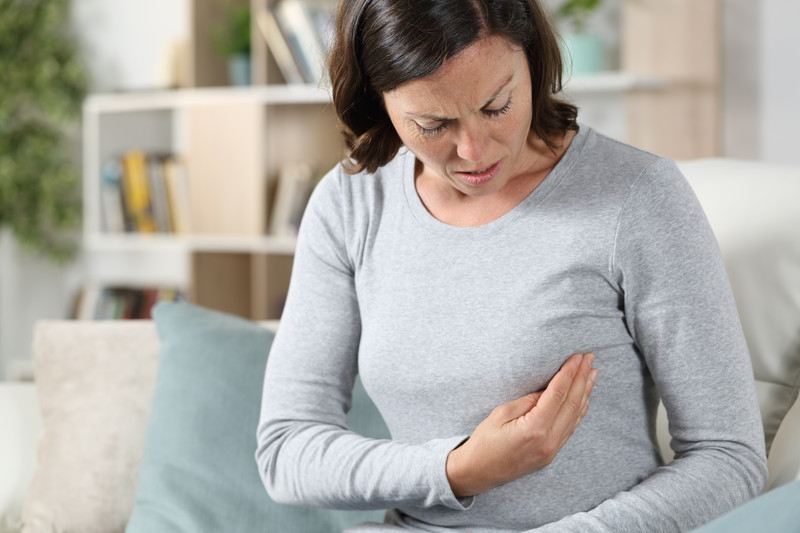Early detection of breast cancer, when the tumour is still small, results in better outcomes.
In the early stages of breast cancer, when a tumour is small, there is usually no pain and no obvious signs and symptoms. It may not be easy to feel a lump, so screening mammography is the best method of detection. However, as the cancer grows, obvious changes in the breast may appear, and these need to be checked by your doctor:
Always be alert for new lumps or thickened tissue, changes in nipple or breast shape or size, and unusual pain which won't go away. If you notice any of the following breast changes, it is very important that you show your doctor.
Make sure you Touch, Look and Check your breasts regularly. See our guide to TLC.
If you have any questions, please call our breast nurses on 0800 BC Nurse (0800 226 8773) or email for advice.
A new lump or thickening

A lump or thickening is not always a sign of cancer but show your doctor to rule it out, especially if it's only in one breast.
Lumps might be felt in the breast, armpit area or around the collarbone. Cancerous lumps often feel hard but sometimes it could be just a thickening in the breast tissue which feels different to the rest of your breast. It doesn't move around in the breast but it will continue to grow over time. Breast cancers are usually not painful.
The average size of a lump found by a woman checking her breasts is 22mm, but a mammogram can detect lumps as small as 2mm.
If you notice any changes in your breasts, see your doctor.
An inverted nipple

One of the more noticeable changes is a newly retracted or turned-in nipple, but most women don't know that this is a possible sign of a tumour in the breast. Even a partial retraction or deviation should be reported to your doctor. Cancer is not the only cause of new nipple inversion - inflammation or scarring of the tissue behind the nipple may also have caused it. However, it is important to see your doctor if you do notice that your nipple has become retracted as it may mean that a breast cancer is growing in a duct behind the nipple, gradually pulling it into the breast.
Nipple discharge

If you notice a discharge from your nipple (that occurs without squeezing), show your doctor. It could be any colour, not just bloodstained or clear. Studies have shown that if there is no blood in a nipple discharge, women are likely to ignore it, but the absence of blood doesn't guarantee that there isn't a sinister cause.
Nipple discharge could also be caused by birth control pills, medicines, infection or a benign growth in the ducts but it's important to check with your doctor, as soon as you notice it, to rule out breast cancer.
Crusty nipple

Some women experience crustiness on or around their nipple. Sometimes it's like a red rash or flaky, scaly skin. It may also feel like an itchy or burning sensation. A crusty nipple could be caused by eczema, breastfeeding, or be a reaction to a new soap, but it can also be a sign of a rare type of breast cancer - Paget's Disease of the Breast - so it should be checked by your doctor. Other nipple changes, such as the nipple pointing in an unusual direction or changing shape, should also be checked, just in case.
Dimples, puckering or dents

Some women notice dimples, puckering or dents on their breasts. These can appear anywhere, even on the underside of the breast and could be caused by a breast tumour pulling the overlying skin inwards. A good way to check for this is by standing in front of the mirror and lifting up your arms. Do you notice any areas on your breasts where your skin pulls inwards? If you spot anything unusual, make sure to get checked by your doctor as soon as possible.
Reddened, orange-peel-like skin

A change in breast colour, with progressive reddening or inflammation needs to be checked out to exclude a rare but fast growing type of cancer - inflammatory breast cancer. The breast is very swollen and usually feels heavy or achy. The skin is thickened and may look like orange peel. Redness, or sometimes a pink flush occupies at least one third of the breast. Occasionally there might be a bruised appearance. Sometimes this is confused with a breast infection but it does not respond to antibiotics.
Shape change

You should show your doctor if you notice any new change in the shape or size of your breasts. This could include unexplained swelling or shrinkage of the breast, particularly in just one breast. It is common for women to find that one of their breasts is a different size to the other – they are normally asymmetric – but if you notice a new change, you should book an appointment with your doctor.
Tip from our nurses. Check if your regular bra isn't fitting as well as usual.

